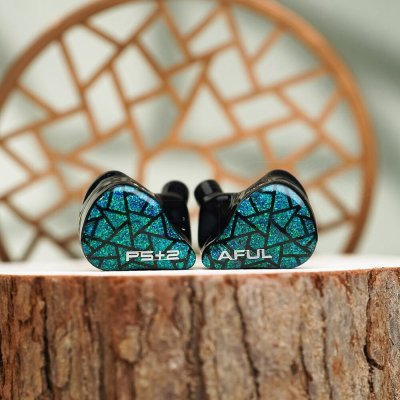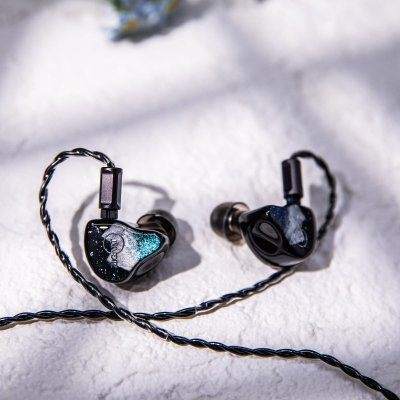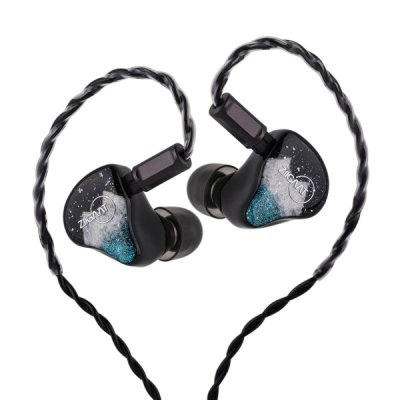Aful Performer 5+2 and Ziigaat Horizon use 2DD+4BA+1Planar and 1DD+2BA+2Planar driver setups respectively. Aful Performer 5+2 costs $229 while Ziigaat Horizon costs $329. Ziigaat Horizon is $100 more expensive. Ziigaat Horizon holds a clear 0.5-point edge in reviewer scores (7.6 vs 8). Ziigaat Horizon has slightly better bass with a 0.3-point edge, Ziigaat Horizon has better mids with a 0.5-point edge, Ziigaat Horizon has significantly better treble with a 1.1-point edge, Ziigaat Horizon has slightly better dynamics with a 0.3-point edge, Ziigaat Horizon has significantly better soundstage with a 1.1-point edge, Ziigaat Horizon has significantly better details with a 1.3-point edge and Ziigaat Horizon has significantly better imaging with a 1.3-point edge.
Insights
| Metric | Aful Performer 5+2 | Ziigaat Horizon |
|---|---|---|
| Bass | 7.9 | 8.1 |
| Mids | 7.7 | 8.2 |
| Treble | 7.2 | 8.3 |
| Details | 7.2 | 8.4 |
| Soundstage | 7.2 | 8.3 |
| Imaging | 7.2 | 8.5 |
| Dynamics | 7.3 | 7.6 |
| Tonality | 7.6 | 8.1 |
| Technicalities | 7.5 | 8.5 |
Aful Performer 5+2 Aggregated Review Score
Average Reviewer Scores
Average Reviewer Score:
7.6Strongly Favorable
Ziigaat Horizon Aggregated Review Score
Average Reviewer Scores
Average Reviewer Score:
8Very Positive
Reviews Comparison
Aful Performer 5+2 reviewed by Z-Reviews
Youtube Video Summary
Naming drama aside (P5+2? just call it Performer 7), this Aful packs a quirky driver party: 2DD for low end, 4 BA split across mids/treble, plus a tiny micro-planar for the highest sparkle, all marshaled by Aful’s neat miniature crossover. The shells are lightweight, comfy and prettier than they need to be; the cable feels “don’t bother swapping” nice, with 3.5 or 4.4 options. The box is loaded with silicone tips but no foam—a miss, because the right seal changes everything. Price target sits around $250, which sets expectations high but not ridiculous.
Stock silicone yields a surgical, respectful tuning with bass that skews neutral and controlled. Swap to well-sealing foam or hybrids and feed a juicy source (warm Class A or tubes) and the set wakes up—stage snaps into a cohesive scene right in front, imaging gets laser-etched, and that micro-planar adds a pinch-of-salt treble spice without turning harsh. It’s an up-close presentation—sometimes almost claustrophobically detailed—in the best way: think “men with trumpets in the head,” precise placement, and excellent extension up top. Not as rowdy as the Explorers; more like a surgeon in a Hawaiian shirt—technical, but with a wink.
Practical upside: the clarity and positioning make this great for gaming and even viable for mixing/mastering checks; just don’t crank it into pain territory. Bass stays tight and responsive, treble sails high, and coherence holds. Tip and source matter a lot: with foam + warm power, it sings; with plain silicone, it’s merely polite. Final tally: a confident 8.5/10—doing a lot right at its price, dinged half a point for making everyone do math on the name.
Z-Reviews Youtube Channel
Buy Aful Performer 5+2 on HiFiGO
Ad
Price: $213
Buy Aful Performer 5+2 on HiFiGO
Ziigaat Horizon reviewed by Z-Reviews
Youtube Video Summary
Ziigaat’s Horizon goes for a flashy tribrid recipe—1×10 mm bio-dynamic for slam, 2×BA for mids, and dual planar treble up top—wrapped in pretty shells and “horizon” art. Street price hovers around $329, though bundle quirks can drop it to roughly $283. The cable is the familiar modular “big boy” plug system (3.5 mm/4.4 mm), chunky but perfectly usable, and the case/tips kit is typical Ziigaat: practical with a dash of theatrics.
Sonically, this one is bold and a bit unnatural—in a good way. Think W-shaped: bass, mids, and treble all step forward, almost competing for attention. The low end hits with big, big bass energy when the track calls for it yet doesn’t trample everything on softer material. Stage is not very wide—more focused and up-front—but there’s satisfying detail/decay and an aggressive, engaging center image. Expect excitement and texture over air and spread, and expect some fatigue after long sessions.
Call it an interesting outlier rather than a safe neutral. Price/performance feels fine (the sweet spot would be closer to $250), and it fits Ziigaat’s “many flavors, similar price” playbook. For listeners stacked with natural-tuned sets and craving a different, punchy, attention-grabbing presentation, Horizon delivers; for chill, long-haul listening, there are calmer choices.
Z-Reviews Youtube Channel
Buy Ziigaat Horizon on Linsoul
Ad
Price: $329
Buy Ziigaat Horizon on Linsoul
Aful Performer 5+2 reviewed by Jaytiss
Youtube Video Summary
Aful Performer 5+2 lands as a hybrid of the beloved Performer 5 and the punchier Explorer. The unboxing is the familiar P5 affair—same case, same style of tips—nothing flashy, but solid. The shell mirrors the P5 in size with a comfy little stabilizing wing that locks in well. No metal nozzle or front filter here, yet tip retention is secure and hassle-free. The flat 2-pin socket is straightforward, and the stock cable feels thick and supple with a reliable chin slider and handy red/blue channel markers. Overall: understated build, great ergonomics, daily-driver ready.
Sonically, this one aims neutral with a very distinct top end—clean, dynamic, incisive. Think switching from black-and-white to color; cymbals and overtones pop with a slightly crunchy/pristine edge that energizes detail without turning harsh on good recordings. Bass isn’t about sheer quantity; it’s about slam and dynamics—quick on the draw, well-controlled, and satisfying when called upon. Vocals sit a notch forward, microdetail is strong, and the overall presentation is coherent, clear, and technical with convincing stage, resolution, and imaging. Not a treble-shy or bass-bombed tuning—more a refined all-rounder for those who want clarity and bite.
Versus the original P5, the 5+2 fixes the missing “air” and soft edges, trading them for crisper transients and better extension. Compared with Explorer (a value champ), the 5+2 brings superior upper-treble reach, detail, and vocal focus. Against Performer 8 and Cantor, it feels more visceral—the P8 is smoother and more relaxed, while Cantor pulls finer microdetail but with less bass slam. Sets like Dino Quattro or J’s Estrella bring bigger fun or treble theatrics, yet the 5+2’s balance and everyday versatility win more often. Net take: a neutral-leaning, highly technical upgrade that stands tall in its bracket—easy to recommend to anyone chasing clarity, speed, and controlled impact over pure warmth or excess bass.
Jaytiss Youtube Channel
Ziigaat Horizon reviewed by Jaytiss
Youtube Video Summary
The ZiiGaat Horizon arrives as the brand’s first tribrid at around $330, pairing one dynamic driver with two BA and two planar drivers. Build is solid: a vented, flat 2-pin socket, metal nozzle, and a distinctive blue-white faceplate that looks like mountains under stars. The cable feels premium with red/blue channel dots and a working chin slider, plus an easy swappable plug (3.5 mm); the included zip case is pleasantly sturdy. Nothing flashy in shell shape, but the fit is secure and the accessories feel thoughtfully sorted.
Sonically, Horizon takes a clean, sub-bass-focused route with bass that reads linear and occasionally a touch pillowy, followed by full, rich upper mids and a treble presentation that steals the show. There’s generous upper air and extension with a tactful lower-treble rise, kept in check by a helpful 5–6 kHz dip to avoid fatigue; a splash of ~15 kHz energy adds sparkle that treble fans will relish. The result sidesteps the “EQ’d-to-death” flatness—this tuning carries just enough color to stay engaging while remaining clean and controlled.
Against peers, Horizon’s top end feels more refined than ZiiGaat’s Luna, while Crescent plays thicker and more V-shaped with extra 10 kHz “twinkle.” Versus sets like the SL224, Horizon’s treble is smoother and less sibilant; compared with Punch Audio Martillo, think of Horizon as the treble-head counterpart to a bass specialist. It also mirrors some strengths of AFUL Performer 7 but with cleaner bass and a more polished top end, and it offers more microdetail than the hard-to-find YU9 Chuer. Taken together, this is a special package: a well-built, distinctive tribrid with 10/10 treble energy and air, competitive technicals, and a tuning that treble lovers will find hard to put down.
Jaytiss Youtube Channel
Aful Performer 5+2 reviewed by Super* Review
Youtube Video Summary
Aful’s Performer 5+2 upgrades the original hybrid with 2DD + 4BA + 1 micro-planar tweeter and lands around $240–$250. The unboxing is practical: three sets of silicone tips, a pocketable puck case, and a soft, nicely draping cable (available in 4.4 or 3.5), though the braid can look a bit loose and the pre-formed hooks run large. The resin shells shift between blue and green under different light; fit is medium-large, very stable, and comfortable once the right tips are found. Note the narrow nozzle without a retaining lip and partially exposed bores/filters—tip grip is key and a little care prevents ear-gunk ingress.
Tonally this leans mild V-shaped: a clean midrange with a confident bass boost, a touch of lower-treble presence for bite, and well-extended air up top. The result is more incisive and punchy than the original P5, with clearer on/off transients that aid separation and layering. Trade-offs show as a hint of gritty/plasticky treble texture on cymbals and brushes—not harsh, but less natural than ideal—while the bass stays tight and exciting.
Against Aful’s Explorer, this sounds brighter, more spacious, and more technical; Explorer plays warmer/denser with smoother treble but less openness. Versus the pricier Thieaudio Oracle MK3, tuning is broadly similar: Oracle is smoother and deeper with a softer attack, while the Performer 5+2 brings more snap and engagement for less money. As a modern mid-tier hybrid, it absolutely still has a place—energetic, spacious, and well-executed—earning a solid four stars.
Super* Review original ranking
Super* Review Youtube ChannelZiigaat Horizon reviewed by Super* Review
Youtube Video Summary
The Horizon aims for a neutral-natural tonality with a slightly lean lower midrange, delivering standout vocal transparency and crisp separation. Bass is mostly sub-bass focused—felt and supportive rather than boomy—giving notes a pleasing sense of density without smearing the mids. The trade-off is an elevated upper-treble that adds air and detail but can tilt gritty/sandy if the fit or tips aren’t dialed in.
Build and accessories are a mixed bag: a surprisingly nice carrying case and swappable termination, but a fussy cable and a resin shell that fits deep and may need shorter, grippier tips to shine. Once seated well, the Horizon’s imaging and instrument separation pop, making complex mixes feel organized and engaging.
Versus pricier hype pieces with similar FR, the Horizon feels like a “short king” take: not as refined up top as the best of them, yet more weighty and satisfying than some leaner peers. Compared to something like Volume S at a similar price, this set is clearer and more incisive (better separation), while Volume S is fuller and smoother with punchier bass presence. At $330, it’s the most compelling entry in its family so far—addictive for transparency and staging, with the caveat of treble sensitivity and fit quirks.
Super* Review original ranking
Super* Review Youtube ChannelAful Performer 5+2 reviewed by Audionotions
Ziigaat Horizon reviewed by Audionotions
Aful Performer 5+2 reviewed by Jays Audio
Youtube Video Summary
Performer 7 lands with a neutral-balanced, laid-back tuning and good treble reach. The presentation is clean and generally safe, though there’s a touch of sizzly “planar-ish” timbre up top. Technicals are solid for ~$200—slightly behind sets like Quintet and Super Mix 4, about on par with Nova. Bass from the dual 6 mm DDs is tight, controlled, and free of bleed, but lacks the slam and rumble of competitors using larger drivers; mids are well separated with decent layering.
The weak spot is vocal extension: a push around 1.5 kHz tries to bring them forward, but a dip through 3–6 kHz keeps them from opening up. Tamer upper-mids help avoid fatigue for rock/metal, yet the modest low-end impact leaves drums and basslines feeling uneventful. It’s a mid-volume set that doesn’t scale well—turning it up accentuates the 1.5 kHz emphasis and treble sizzle. Treble isn’t peaky, just a bit glassy at times; for K-pop the smoother mids can work if less extended vocals are acceptable.
As a value play, there are stronger options: Nova, Chopan, and Super Mix 4 offer better bang-for-buck; for a similar clean/neutral target, Tanchjim Origin sounds more natural with better bass texture and vocal reach, and DynaQuattro adds sub-bass and fuller vocals—none with the planar-ish timbre. Even AFUL’s own P5 is cheaper and more fun, while the Explorer undercuts the price and scales impressively. In today’s crowded market, P7 is a competent all-rounder but not distinctive enough to stand out.
Jays Audio Youtube Channel
Ziigaat Horizon reviewed by Jays Audio
Youtube Video Summary
Ziigaat’s Horizon follows the current meta-inspired recipe—think Astral, Metas, Crescent—but pushes the focus upward: the treble is the most prominent piece here. It’s bright-leaning without turning harsh, giving a crisp, “OCD-like” sense of transient bite and pinpoint imaging. Low end and vocals sit a touch behind the highs, so the presentation feels clean and lively rather than thick; at mid-volume, the top end drizzles detail over the mix like raindrops—engaging and textured, not shouty.
On the technical side, Horizon pulls strong detail retrieval and resolution for the price—above sets like Supermix 4 and near EM10/Volare —yet it doesn’t scale massively because of that treble lift. The bass is snappy and controlled, with good separation, but lacks the slam and rumble seekers of impact will want. Pairing and playlist matter: avoid hot, highly produced pop/K-pop/J-pop or most hip-hop where the combo of elevated highs and lighter bass can feel edgy; it shines with slower pop, R&B, indie acoustics, ballads, and classical where the sparkle reads as “high-fidelity.” Warmer sources help a bit, and tip-rolling (stock black/clear, or bass-adding options like Final E/divinus) can balance things—just skip anything that pushes treble further.
Against close competitors, Astral hit harder down low and feel more V-shaped and contrasty; Crescent is warmer and smoother but not as clear or micro-detailed. Horizon is the cleanest and brightest of the trio, with the most refined treble focus and “tickly” transients. Verdict: a value-minded all-rounder for detail lovers who prefer clarity and air over bass authority—technical, tidy, and energetic at sensible volumes, provided the library isn’t a treble minefield.
Jays Audio Youtube Channel
Aful Performer 5+2 reviewed by Paul Wasabii
Youtube Video Summary
The AFUL Performer 5+2 takes the familiar hybrid recipe of dual 6 mm dynamics, four balanced armatures and a micro planar and spins it into a distinctly vocal focused presentation. Vocals are pushed very close, giving an intimate, close talker character that will immediately stand out from more typical U shaped hybrids. This forwardness comes at a cost, as the overall soundstage feels flatter and smaller than many competitors, with the midrange taking center stage at the expense of a more spacious image.
The dual 6 mm drivers deliver a sub bass tilted low end that has respectable rumble and enough level to support genres that appreciate extra weight, while avoiding obvious boom or bloat. Impact and tactility are on the softer side, and combined with the elevated midrange and treble, bass presence tends to sit very close to the vocals rather than carving out its own layer. This crowding effect, together with the warm, smoothed textures, means layering and separation never really open up, giving the Performer 5+2 a more compact, blended presentation than many modern tribrids.
The treble region is where the tuning feels least controlled, with peaks across the upper mids, presence and air bands that can bring out snare hits and sibilants and push the micro planar into an overdriven, slightly unnatural timbre. The intended advantage of the micro planar is largely lost in this boost, keeping overall technicalities such as detail retrieval, imaging precision and stage depth firmly in the moderate camp rather than a clear step up from AFULs other models. As a result, Performer 5+2 emerges as a niche choice for listeners who strongly prioritize upfront vocals and do not mind a smaller, more intense stage, while those looking for a more balanced, spacious and natural presentation will likely find better options elsewhere.
Paul Wasabii Youtube Channel
Ziigaat Horizon reviewed by Paul Wasabii
Youtube Video Summary
ZiiGaat Horizon is a $329 tribrid (1DD+2BA+2MPL) that prioritizes treble extension, clarity, and very sharp imaging. Compared with EPZ P50 and Daybreak, ear-gain is set lower, which yields less shout and more natural vocals while keeping an even transition from lower to upper treble. The result is a clean, transparent presentation that reads more refined than typical $300 hybrids and feels end-to-end coherent.
The trade-offs sit mostly in the low end and upper-treble edges: the stock mid-bass dip reduces body and impact, and sibilants can pop, especially around 8 kHz. Bass quality itself is quick and tidy with good depth rather than rumble, matching BA/MPL speed but leaning lean for bass-heavy genres. A light EQ lift of lower mids/mid-bass (about 2–3 dB) and a small 8 kHz trim (around 0.5–1 dB) makes it a more versatile daily driver while preserving its separation and sense of stage depth.
Paul Wasabii Youtube Channel
Aful Performer 5+2 reviewed by Web Search
The AFUL Performer 5+2 (also listed as “Performer 7”) uses a 2DD+4BA+1 micro planar driver array and AFUL’s LC-network crossover plus a 3D-printed acoustic tube system, aiming for clean band splits without smearing. The shell also integrates a high-damping air-pressure balance system, a design AFUL has used across its line. Official listings put MSRP around $229 and outline the same core tech features.
Tonally it trends neutral with a sub-bass lift: bass has solid depth and texture, mids stay relatively linear, and the presence/treble region adds energy without veering into sharpness on most chains. Multiple reviews characterize it as warm-neutral with bass boost or slightly V-shaped depending on perspective, which matches listening notes about a lively but controlled upper end. Sensitivity and load are portable-friendly (≈109 dB, 15 Ω), so it reaches performance without demanding amplification.
Technicalities are competitive for the class: imaging is tidy with good instrument separation, micro-detail retrieval is above average, and soundstage is moderate (more width than depth). Build and comfort are typical resin-shell fare; some users note occasional lower-treble bite depending on tips and recordings, so treble-sensitive listeners may wish to pair accordingly. Overall value is strong at its price, especially if a clean, bass-supported neutral curve is the priority.
Ziigaat Horizon reviewed by Web Search
Ziigaat Horizon is a tribrid IEM that combines 1DD + 2BA + 2 planar drivers, positioned at an MSRP of $329; this configuration aims to split bass, mids, and treble duties across specialized transducers for coherence and headroom. These fundamentals are confirmed on the brand’s product page and storefront listings.
Subjectively, community impressions describe robust sub-bass from the dynamic driver, clean mids from the BAs, and airy treble from the planar tweeters, with multiple listeners highlighting a notably expansive soundstage. Head-Fi reviews and threads also call out treble extension claims “up to 40 kHz” and above-average staging for the price class.
In tuning terms, the Horizon trends U-shaped: lifted bass and upper-treble energy provide excitement and perceived width, while midrange presence is more neutral than forward—favorable for pop and electronic but less ideal if you prioritize warm, intimate vocals. Reports also note that pairing and tips can influence perceived brightness and staging, so synergy matters if you’re treble-sensitive.
Aful Performer 5+2 (more reviews)
Aful Performer 5+2 reviewed by Audio Amigo
Youtube Video Summary
The AFUL Performer 5+2 (Performer 7 / P7) takes the P5 recipe and adds a second 6 mm dynamic for the lows and a micro-planar for the highs, nudging MSRP to $240. Unboxing mirrors the P5: nine pairs of tips and a decent case, but the accessories feel bare-bones at this price—no foam tips and a non-modular cable, even though the included 8-wire is supple and well-behaved. Build is classic AFUL: 3D-printed resin, blended nozzle (no mesh or lip—watch tip retention), single rear vent, and striking blue-green mosaic shells inspired by Suzhou gardens—cool-wall approved with four compliments to one “meh.” Fit is semi-custom and a touch chunkier than P5; comfortable for most, a conditional pass for small ears. Note a sporadic batch quirk: some units have over-tight 2-pin sockets; exchanges fixed it for affected buyers.
Tuning sits in warm-leaning neutral territory. The dual dynamics deliver punchy, textured bass that rumbles without bloating; guitars and drums carry convincing weight. Mids are the star—rich, full-bodied, vocal-forward without shout, with clean separation and natural tone. Treble from the micro-planar is smooth yet energetic: cymbals and vocal harmonics sparkle, special effects have bite and body, and only treble-sensitives may find hot mixes a bit lively. Technicalities impress for the money—detail retrieval and nuance feel a class up—while stage and imaging are solid rather than showy.
Against peers: the Tangzu x HBB budget pick mirrors the overall tonality but P7 offers higher resolution and more treble finesse; the planar “Heyday” alternative is brighter/faster with leaner bass; versus Performer 5, P7 brings tighter low-end, smoother treble, and better extremes detail; the Fresh-collab competitor pushes vocals further forward with bigger stage but leaner lower mids. Verdict: a versatile all-rounder that suits broad libraries and even content creation thanks to its balanced tonality and detail. Not for bassheads, trebleheads, or strict Harman-lean seekers, and the accessory pack/cable quirk holds it back from a slam-dunk. For roughly $240, though, it’s a brilliant, resolving upgrade in the AFUL line.
Audio Amigo Youtube Channel
Aful Performer 5+2 reviewed by Audio-In Reviews
Youtube Video Summary
The AFUL Performer 5+2 continues AFUL's streak of strong releases in the mid tier, bringing a tribrid driver setup into the very competitive 200 to 300 dollar range. The shell is well finished, slightly larger than the original Performer 5 but still very comfortable, with careful contouring that avoids hot spots in daily use. Build quality feels solid, the faceplate design is arguably AFUL's best yet, and the soft, easy to manage cable complements the overall aesthetics very nicely.
Sonically the set sits between neutral and mild V-shaped, with a boosted bass and a bit of extra treble energy while the mids stay slightly relaxed. Bass quantity is north of neutral, focused below roughly 200 to 300 hertz with good extension, giving a punchy, dynamic and physical low end that provides a visceral sub bass experience without noticeable bleed into the mids. A touch of extra low mids adds warmth, note weight and richness to male vocals while the midrange remains clean, detailed and natural, without odd peaks or dips. Treble carries some of the delicate character expected from a micro planar driver, with forward lower treble that adds bite and energy, plenty of upper treble extension, shimmer and air, staying engaging without becoming harsh or fatiguing; only a slightly less natural cymbal timbre versus sets like Da Vinci, Dino Quattro and Butterfly 61T stands out as a minor nitpick.
Technical performance is very strong for the price, at least on par with the Butterfly 61T, previously a reference for technicalities around 200 dollars, and the Performer 5+2 may even edge it out in soundstage and imaging, which come across as slightly above average versus other in ear monitors in this range. Within the 200 to 250 dollar bracket it can reasonably be considered one of the best technical performers available, while still offering an engaging, airy and exciting tuning that many listeners could daily drive. Those who prefer a smoother, more relaxed upper mid and treble presentation might still lean toward the Butterfly 61T, but the Performer 5+2 earns a very strong recommendation for anyone wanting a more lively, high performing tribrid that competes confidently among the top options in this segment.
Audio-In Reviews original ranking
Audio-In Reviews Youtube ChannelAful Performer 5+2 reviewed by Kois Archive
Kois Archive Youtube Channel
Aful Performer 5+2 reviewed by Gizaudio Axel
Gizaudio Axel original ranking
Gizaudio Axel Youtube ChannelAful Performer 5+2 reviewed by Tim Tuned
Ziigaat Horizon (more reviews)
Ziigaat Horizon reviewed by Joyce's Review
Youtube Video Summary
ZiiGaat Horizon is a tribrid with one dynamic driver, two balanced armatures and two planars that combines a beautiful hand painted faceplate with a very balanced sonic presentation. Bass focuses on sub bass with an 8 to 9 dB shelf that feels tight, impactful and well controlled, giving a wide and comfortable stage without becoming overly warm. The shell in medical resin, the detachable silver plated cable with both 3.5 and 4.4 plugs and the firm orange carrying case round out a package that feels thoughtfully put together at its 329 USD price.
On the low end the sub bass reaches under the ears and around the neck with good depth, fast decay and clean retrieval, so kicks hit with satisfying punch while never smearing into the mids. Lower mids stay relatively flat to provide a balanced foundation, and vocals come across three dimensional, intimate and well focused with a strong sense of vertical soundstage and clear separation from instruments. Male voices sound full and weighty, female vocals are bright and natural, and midrange instruments are layered, tight and elastic with controlled decay that keeps the presentation lively without excess reverb.
Treble is airy and open with careful dips around 5 to 8 kHz to reduce sibilance, then a well judged peak in the upper treble that extends past 20 kHz, adding space and air without turning cymbals or high hats piercing. Across the band the separation between bass, mids and treble is excellent, imaging feels precise and stable and detail comes through in a granular yet natural way that compares favorably even to more expensive tribrids like the Dunu DK3001. For listeners who enjoy balanced, vocal centric music with clean, extended treble and long term comfort, Horizon offers a refined, beautiful and emotionally evocative listen that really does feel like a fresh dawn for the ears.
Joyce's Review original ranking
Joyce's Review Youtube ChannelZiigaat Horizon reviewed by ATechReviews
Youtube Video Summary
The ZiiGaat Horizon comes with a solid accessory package for its price, including a spacious hard case, a modular 3.5 and 4.4 cable that is soft and easy to manage, and a good selection of silicone and foam tips that seal well and feel comfortable. The resin shell with metal lip nozzle feels stable in the ear, with venting that avoids pressure build up or driver flex and an average size that sits securely even when walking around. The colorful faceplate with sparkles, flat two pin connector and overall ergonomics make the Horizon look and feel like a well built, everyday friendly in ear.
Sonically the tuning leans sub bass focused at a neutral level, delivering tight, clean, textured bass with natural decay and a strong sense of physicality that stays neatly separated from the mids so vocals and instruments remain clear. The midrange is mostly neutral and very clear sounding, with vocals sitting nicely forward without becoming shouty and a balanced note weight that gives male voices depth and female voices an open, airy quality. Separation and timbre in the mids are excellent, making instruments sound realistic and well layered while clear forward vocals remain free of harshness.
The lower treble on the Horizon is smooth, controlled and detailed without obvious peaks, while the boosted upper treble brings a crisp, airy, sparkly character with plenty of shimmer and micro detail on cymbals, hi hats and upper harmonics, though listeners sensitive to upper treble may find it a touch bright. Overall treble avoids sounding splashy or metallic and works with the open bass and midrange to give the set a spacious, airy feel. In terms of technical performance the Horizon is one of the more resolving options at this price, offering excellent detail retrieval, separation and imaging, and in comparisons it tends to trade the heavier bass and warmth of rivals like Crescent, Astral, Kir SPET, Volume S, Sivo 24 or Zens T Pro for cleaner mids, more upper treble air and clearer vocals, making it ideal for listeners who value clarity and vocal focus over sheer low end quantity.
ATechReviews Youtube Channel
Ziigaat Horizon reviewed by
 Fresh Reviews
Fresh Reviews
Youtube Video Summary
Ziigaat Horizon arrives as a striking tri-brid in the ~$300 bracket (1DD + 2BA + 2 planar) with a tuning that brushes close to Kiwi Ears Astral yet comes across a touch thinner and more balanced. The low end focuses on sub-bass rumble that’s tight, clean, and richly tactile, while mids keep timbre accurate and treble stays controlled—never shouty or fatiguing—yielding a fun-yet-almost-reference presentation. Build and comfort impress: ergonomic shells with that aqua-to-silver fade can be worn for 8-hour sessions, and the package includes Ziigaat’s new two-pin cable with interchangeable terminations (3.5/4.4), a roomy faux-leather case, silicone sets plus foams; tip rolling (e.g., ASMR tips) pairs well.
In games, ambient clutter drops away and crucial cues get spotlighted with confident imaging, separation, and convincing verticality. Footsteps in Valorant are clear and positional, though the lightest taps can blur a bit under nearby low-end rumble or heavy gunfire; Apex performance is exceptional, just a hair behind Astral/Mangird Tea Pro when ultimates stack; Call of Duty delivers satisfying impact with disciplined decay, though micro-cues can soften during chaos. Net-net, Horizon is a great all-rounder with clean, technical bass and a natural balance that works across titles. On the WallHack list it gets A– overall (A– in Apex, B+ in CoD, Valorant just shy of top marks), primarily nudged down by occasional masking of the lightest cues during intense mixes.
Fresh Reviews original ranking
Fresh Reviews Youtube ChannelZiigaat Horizon reviewed by Head-Fi.org
Aful Performer 5+2 Details
Driver Configuration: 2DD+4BA+1Planar
Tuning Type: Neutral with Bass Boost
Brand: AFUL Top AFUL IEMs
Price (Msrp): $229
Support our free service! Buying through our affiliate links costs you nothing extra:
Ziigaat Horizon Details
Driver Configuration: 1DD+2BA+2Planar
Tuning Type: Neutral, Neutral with Bass Boost
Brand: ZiiGaat Top ZiiGaat IEMs
Price (Msrp): $329
Support our free service! Buying through our affiliate links costs you nothing extra:
Aful Performer 5+2 User Review Score
Average User Scores
Average User Score: n/a
Based on 0 user reviews
No user reviews yet. Be the first one who writes a review!
Ziigaat Horizon User Review Score
Average User Scores
Average User Score: n/a
Based on 0 user reviews
No user reviews yet. Be the first one who writes a review!
Aful Performer 5+2 Gaming Score

Gaming Score & Grade
- The gaming score is prioritizing technical capabilities of the IEM (Separation, Layering, Soundstage) and good value.
Gaming Score
7.5Gaming Grade
AZiigaat Horizon Gaming Score

Gaming Score & Grade
- The gaming score is prioritizing technical capabilities of the IEM (Separation, Layering, Soundstage) and good value.
Gaming Score
8.8Gaming Grade
S-Aful Performer 5+2 Scorings
Average Technical & Tuning Grades
Average Tunign Grade
A- Tuning feels well executed, keeping a natural flow across the spectrum. Switching genres feels seamless.
Average Technical Grade
A- Overall technical control is strong, presenting instruments with clarity and sensible staging. Textures are portrayed with satisfying clarity.
Ziigaat Horizon Scorings
Average Technical & Tuning Grades
Average Tunign Grade
A+- The tonal balance is polished and expressive, highlighting emotion without sacrificing accuracy. It keeps emotional weight without sacrificing accuracy.
Average Technical Grade
S-- You get an articulate, polished performance with immersive stage depth and great control. There's a sense of polish across the whole spectrum.
Aful Performer 5+2 User Reviews
"This is an example review"
Pros
- Example pro 1
- Example pro 2
Cons
- Example con 1
- Example con 2
Share your experience and build your personal ranking list.
You need to be signed in to write your own reviewZiigaat Horizon User Reviews
"This is an example review"
Pros
- Example pro 1
- Example pro 2
Cons
- Example con 1
- Example con 2
Share your experience and build your personal ranking list.
You need to be signed in to write your own reviewFind your next IEM:
IEM Finder Quiz
newIEM Comparison Tool
newVS




































